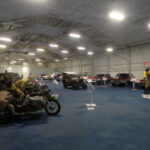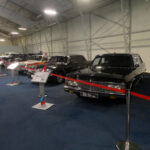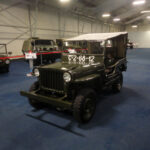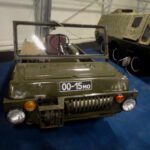Historically, the Kubinka Tank Museum only stored armored vehicles, but not military cars and trucks. Even the museum collection of the Third Reich only had armored trucks and transporters. The Red Army, during local conflicts with Japan during the battles on Lake Khasan and the Halkin Hall River, captured several Japanese military vehicles as trophies. According to the Kubinka Proving Ground Archive, the Kubinka Tank Museum in 1938 had 2 captured Japanese military trucks. The collection also included one of two Christie automobile chassis purchased in the USA, which served as the basis for Soviet light BT tanks and the famous T-34. During the Battle of Moscow in 1941, the front line of World War II passed just 6 kilometers west of the Kubinka training ground and museum. The training ground was evacuated for several months, and the Christie chassis and two Japanese military trucks disappeared. During the Cold War, the Kubinka museum was intended to study Soviet and foreign armored vehicles, but not to preserve the memory of World War II. To study Soviet cars and trucks, there was the Ryazan City Automobile Museum at the military school. To hold military parades on Red Square, there was a Museum at the 147th automobile base of the Ministry of Defense of the USSR/Russia. This base served the Minister of Defense, deputies and generals of all departments in the building of the General Staff and the Headquarters of the Ground Forces. The Main Intelligence Directorate (GRU) had its own separate 37 automobile base. For the daily work of generals 147, the automobile base provided military vehicles of the traditional Volga company, black, with a radio antenna and special numbers, also black. For the Minister of Defense and the commander of the parade on Red Square there were several light-colored open limousines. The Automotive Museum of the 147 base also housed the legendary Katyusha rocket launchers (BM-13) of the Second period, on which the original tire on the wheels was replaced with a new one. After its formation, starting in 2015, Patriot Park, by order of the Minister of Defense, began to receive historical cars and trucks from military units, including the Ryazan Military School and the 147th Automobile Base. Patriot Park has created a separate pavilion for military cars and trucks inside the H1 Museum Site. A private unique collection of Soviet and foreign cars called “Motors of War” was placed in a separate pavilion nearby. The “Motors of War” exhibition included unique military passenger cars of the USSR, Germany, Italy and Japan from the Second World War, purchased abroad or found on the battlefields and restored. For unknown, perhaps financial, reasons, the “Motors of War” exhibition no longer exists; the collection has moved to another location, but we are showing a virtual tour of how it was in Patriot Park. Patriot Park’s own collection of cars also moved to a separate pavilion near the H1 Museum site. Special purpose military vehicles are also located outdoors, including fuel tankers and field kitchens.
Patriot Park Museum site N1 Hall 3 virtual tour
- Patriot Park Hall N3 (2017 archives)
- Black color cars for VIP and generals
- WW2 Lend-Lease Jeep Willys
- Luaz series amphibious vehicles
Patriot Park Soviet and Russian military car exhibits list:
Military parade cars:
- ZIL-115 V (cabriolet) M1981 (3 cars only) for the Red Square military parade (Minister of Defense)
- GAZ-14-05 (cabriolet) M1977-1989, small amount VIP car
- GAZ-24 (cabriolet) , small amount (4 cars) for the Military district parades
Serial and rare military cars:
- LUAZ-967 (TPK) , amphibious car on chassis ZAZ-967
- LUAZ-1901 “Geolog” , M1998
- GAZ-69, military car,
- GAZ-69A
- UAZ-469 armored version, M1972
- UAZ-3172 “Wagon” , experimental military car
- Moskvich-401-420, military/ civilian car, M1954
- GAZ-31105 “Rida” on the Volga 105 chassis M2004
- GAZ-14 “Chaika” , soviet car for VIP
- ZIL-41047, M1985, produced by the small amount for VIP till 2002
Interesting facts about cars and trucks. The largest is the Automobile Museum in Reims, Champagne, which displays a unique collection from the early 20th century. The museum is located on actual battlefields of the First World War and is accessible to visitors. French armored vehicles and military trucks of World War II are in the Saumur Museum, Loire Valley.




